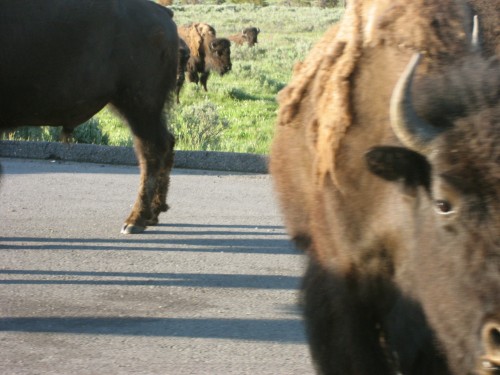Yellowstone National Park spans three states and nearly 3,500 square miles, making it one of the largest parks in the US. So when I read that Montana officials are searching for a home for 135 Yellowstone bison living on Ted Turner’s sprawling private ranch, I was bewildered. Why not just put them back in the park? Anyone who has visited Yellowstone knows that it’s prime habitat. You can’t drive a mile without seeing their shaggy hulking forms. Or better yet, let the bison roam free. After all, isn’t that the definition of a wild animal?
It didn’t take much research for me to realize that the issue is far more complex than I first imagined. Yellowstone already has more bison than officials would like. According to an agreement signed in 2000, the park is supposed to keep the population around 3,000 animals, far less than the 4,600 bison that currently reside there. To curb the population, park officials trap some of the animals and ship them to slaughterhouses, a move that has sparked outrage among environmental groups.
The 3,000-animal limit isn’t based on carrying capacity; Yellowstone could probably support a larger herd. Instead the cap is designed to help prevent bison from migrating out of the park in the winter, when food is scarce. About half of Yellowstone’s bison have been exposed to brucellosis, a bacterial infection that can cause stillbirths and infertility in domestic livestock. Montana’s cattle are free of the disease, and ranchers worry that free-roaming bison could infect their herds.
Whether that would happen is a matter of debate. Critics of the 3,000-animal limit point out that bison tend to leave the park in winter and spring, when few cattle are grazing, and most cattle are vaccinated anyway. What’s more, there hasn’t been a single documented case of brucellosis transmission between wild buffalo and cattle, despite ample mingling between the two in Grand Teton National Park.
The Yellowstone bison on Turner’s ranch don’t carry brucellosis. They’re part of a grand experiment to see if the park can establish herds that are free of the disease. Between 2005 and 2008, researchers removed roughly 200 bison calves that tested negative for the disease and quarantined them outside the park. The goal was to see whether they would remain free of infection through the birth of their first calf. But by 2009 the quarantine facility was full. That’s when the state decided to enlist the help of media mogul Ted Turner, who owns more than 100,000 acres of ranch land in Montana. That’s where he keeps his herd of more than 50,000 domesticated buffalo. You can sample their tasty flesh at Ted’s Montana Grill in Bozeman.
In 2010, officials relocated 87 of the disease-free bison to Turner’s ranch to make space in the quarantine facility. In exchange for housing the animals, Turner was promised 75% of the herd’s offspring. The move was hugely controversial, and sparked a lawsuit. Matt Skoglund of the National Resources Defense Council offered this criticism:
Allowing public wildlife — wildlife from America’s first national park — to be privatized and commercialized sets a dangerous precedent. Forever removing public wildlife from the public domain violates the public trust. Yellowstone’s wildlife belongs to all Americans, and proposing to give away such wildlife as a form of payment is abhorrent. Yellowstone’s public wildlife is not a form of currency. Turner Enterprises should be compensated if it allows the feasibility study to be completed at its Green Ranch, but it should be paid with money (or some equivalent), not Yellowstone wildlife.
The five-year agreement between Turner and the state ends in 2015, at which point Turner is expected to return any members of the original herd and 25% of their offspring. With the deal set to expire, officials put out a request for proposals for what to do with the bison in late March. They hope the disease-free animals can be used to establish a new wild herd elsewhere. And that may happen. But as the National Resources Defense Council points out [PDF], most of the conservation herds scattered across the West “are small, fenced-in, and intensively managed.”
That’s better than nothing, I guess, but it’s so much less than what we once had — tens of millions of bison thundering freely across the plains. I can’t help but pine for what we’ve lost.
**
Photo by Cassandra Willyard. My husband and I got stuck in a buffalo-induced traffic jam for more than an hour in Yellowstone in 2008. By the time we finally started moving again, he was exceedingly annoyed. When we passed the bison that had caused the backup, I asked him to slow down so I could take a photo. He refused. I only managed to capture half the bison’s face.

A number of Indian tribes maintain–or try to maintain–herds of buffalo, and may well welcome additional animals, even if they have to be kept apart for breeding reasons. I’m aware only of my own tribe, the Oneidas of Wisconsin, but I know there are others. USDA’s Tribal Relations people could probably identify many if not all of those others.